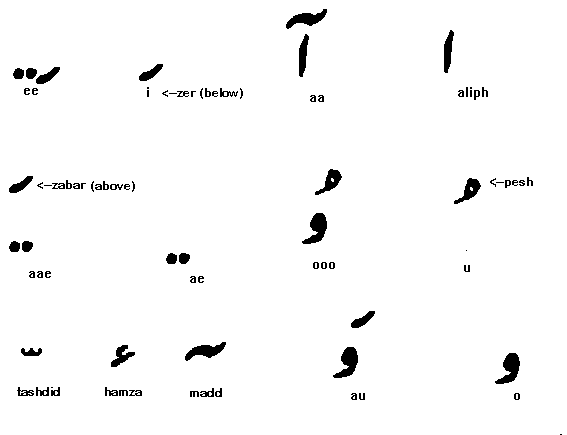
If a word begins with a vowel eg arm , apple , easter etc. an aliph sign is always put before the vowel mark.
Examples below. Note that the first word is a or ugh as in 'U'nder.

Note there are two ae letters. The bottom is used when ae is on its eg Ae cat sat while the one above it is used when AE joins the next letter eg in AEK (one).
If the vowel is not at the start of a word we dont use the vertical aliph and just use the vowel marks as below.  Make sure you can tell the difference between ae and big eee ( there is an extra zer at the bottom for eee). Between u and big ooo and between ooo and au ( au has a zabar on top ). It is important to get up and cram these vowel marks as they make the language very easy to read once you have done that.
Make sure you can tell the difference between ae and big eee ( there is an extra zer at the bottom for eee). Between u and big ooo and between ooo and au ( au has a zabar on top ). It is important to get up and cram these vowel marks as they make the language very easy to read once you have done that.
*As in Hindi the nasal n as in the word song is marked with a dot over the letter.*

The S above can be confused with SH which we will see later , so look at it closely.
 .
.
Looking at the above figure and keeping the sign of the aa vowel ( just a vertical line ) , and keeping in mind where the letter comes in the word ,can you read your first sentence in Urdu ? It has a final form of the i which you have not met before ( in the word KI below). Also note the little omega sign -called TASHDID-at the top of B in ABBA. It is a doubler ie it means you have to say B twice , the first B is half pronounced . Read R to L.

Do you know what the above - Aap ke Abba ki Kitab - means ? It says this book belongs to your father . Abba is urdu for father . Aap means you and kitab is book. Note also that the two dots for the soft te in Kitab are placed well above the line.

The answers are

The unlabelled figure is of course the English word TENT.